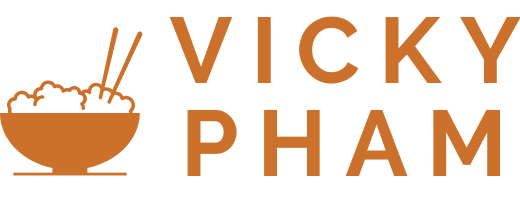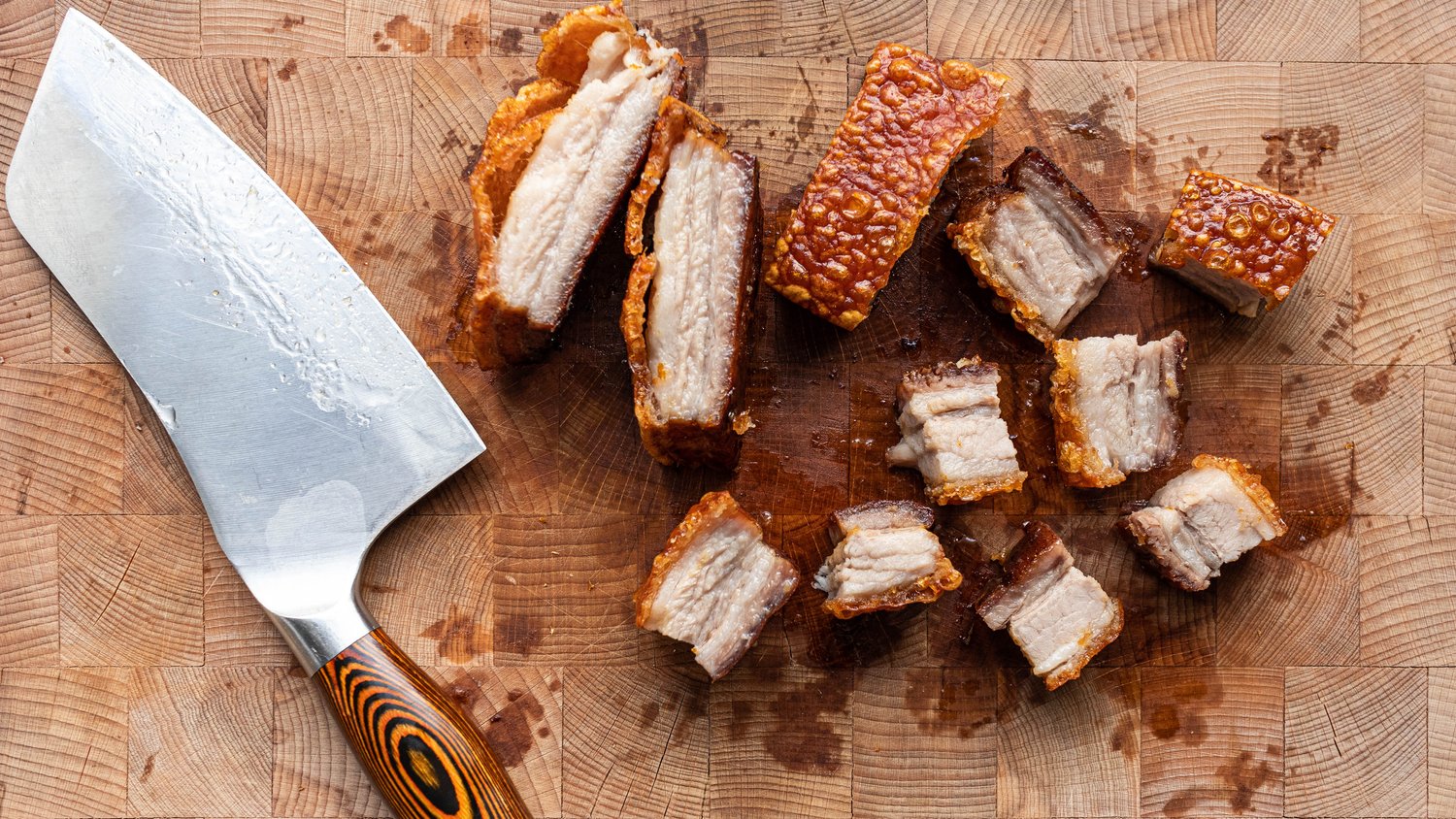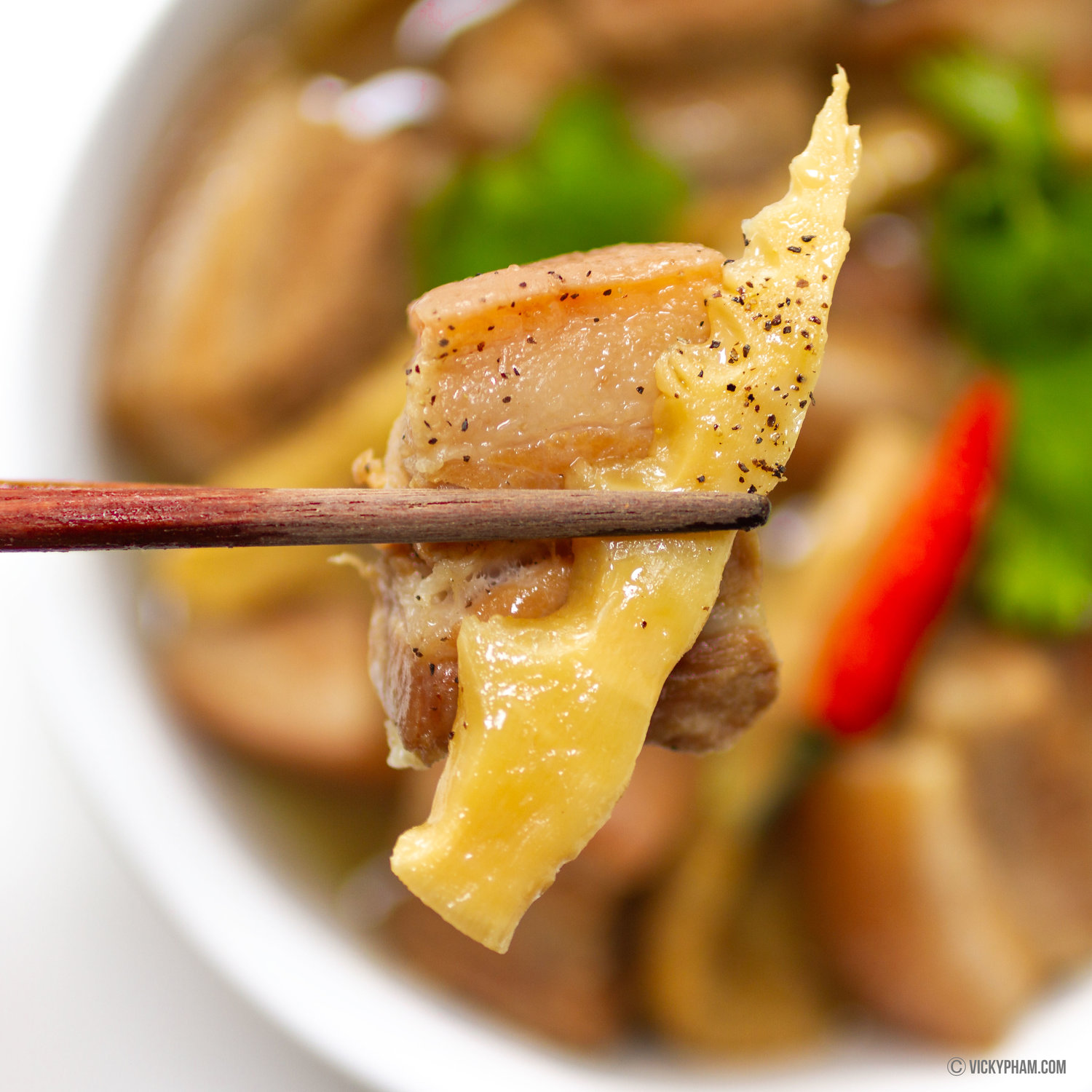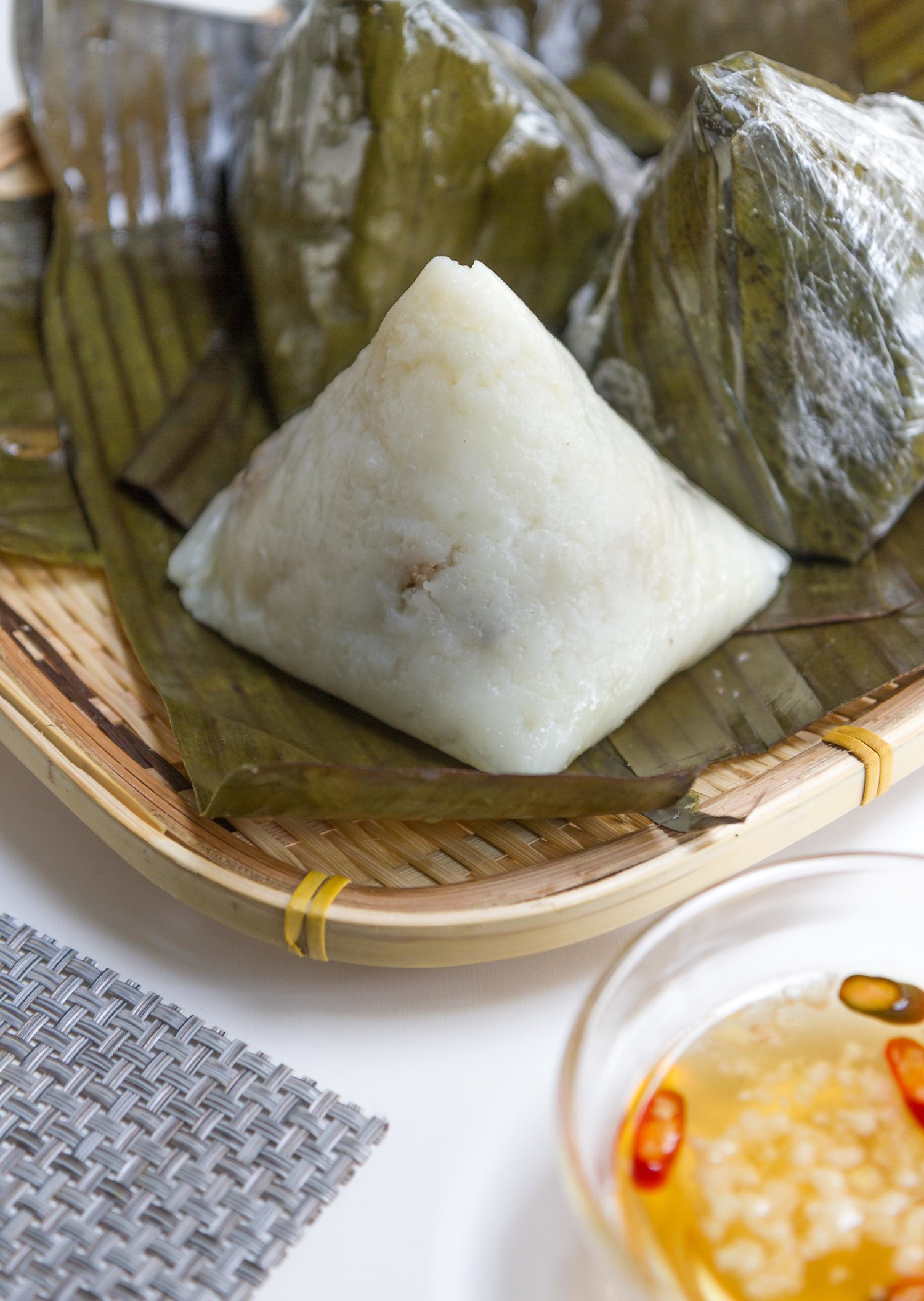Vietnamese Savory Glutinous Rice Cakes with Pork Belly & Mung Beans for Lunar New Year (Banh Tet)
This post contains affiliate links which we are compensated for if a purchase is made. Using links costs you nothing and helps to support the ongoing creation of content. • Jump to Recipe
With Lunar New Year around the corner, it's the perfect time to make Bánh Tét. You got to have them around for the festivities or fail as a Vietnamese adult.
Making Bánh Tét at home may seem daunting, but with this step-by-step guide, a little patience, practice, and maybe a bit of cursing, you too can impress Grandma and other family members.
Just remember, the wrapping is the only tricky part. If all fails, just wrap it haphazardly with a bunch of strings and cover with foil. You’re good.
This recipe includes both stove-top and pressure cooker instructions.
What is Bánh Tét?
Bánh Tét is Vietnamese savory glutinous rice cakes filled with pork belly and mung beans, wrapped in banana leaves.
It’s the quintessential Vietnamese New Year (Tét) food.
These cylindrical bundles of sticky rice are not only delicious but also symbolize prosperity and good fortune in the coming year.
What You Will Need
To make Bánh Tét at home, gather the following ingredients and kitchen items:
Pork Belly: Pork belly is readily available at Asian supermarkets.
Pork belly slabs are usually located at the meat counter towards the back of the store. Ask the nice people behind the counter to select you a piece that is even and thin, about 1-inch in thickness if possible. You also want one with thin layers of fat as pork belly can be extremely fatty.
One slab of pork belly at the Asian supermarket is typically 1-½ lbs which is perfect for this recipe.
If getting the attention of the person behind the counter is too difficult (it happens sometimes), you can pick up pork belly yourself in the refrigerator aisle. These are usually already cut into strips.
The traditional pork belly for Bánh Tét includes the skin, but the choice is yours. Skinless pork belly is a leaner option.
If pork belly is unavailable, substitute with pork shoulder.
Pork Belly
What you will need to make Bánh Tét: banana leaves, sweet rice, and dried mung beans
Glutinous Rice: Glutinous rice is also known as sweet rice. Make sure that the package says sweet rice or glutinous rice to ensure you are getting the right kind.
Mung Beans: Look for dried split mung beans. They are located in the dry good aisles in clear baggies.
Seasonings: To season the pork belly, we will be using shallots, salt, sugar, fish sauce, ground black pepper, and bouillon powder.
I’m using chicken bouillon powder but you can also use mushroom bouillon powder.
Don’t like bouillon powder? No problem. You can replace the amount with a halved amount of MSG.
If bouillon powders and MSG aren’t your thing, simply omit. It will still be great.
Banana Leaves: You can typically find fresh banana leaves at Asian supermarkets. Look for them in the produce section. If fresh leaves are unavailable, some stores also offer frozen banana leaves. Thaw them before use.
Large stock pot with a lid or pressure cooker: To cook the rice cakes, you can either use an 8-quart stock pot with a lid or an 8-quart pressure cooker. Stove top cooking will take about 6 hours. Pressure cooker will take about 2 hours total (1.5 hours cooking and 30 minutes to depressurize).
You might be able to use 6-quart pots but it may be tight.
Strings: When tying the cakes, you can use cooking twine or those colorful plastic ropes commonly found in the houseware section of Asian supermarkets.
In Vietnam, bamboo strings are used. These strings are made from thinly shaved dried bamboo. These are abundantly available in Vietnam and other Southeast Asian countries. Unfortunately, I can’t find any in the States.
This picture is from my very first try. Not too shabby, eh?
How to Make It
Step 1: Overnight Preparation
Rinse the dried glutinous rice grains in a colander until water runs clear. Transfer to a mixing bowl and cover with water. Cover the bowl and let it soak overnight on the counter.
Repeat the same process for the dried mung beans. Drain into separate bowls and season with salt.
To remove surface impurities and any unwanted odor, generously rub the pork belly with coarse salt. Rinse thoroughly under running water to remove the salt and pat the pork belly dry with paper towels.
Season pork belly with salt, sugar, fish sauce, ground black pepper, shallots, and bouillon powder.
Thaw the banana leaves if frozen. Cut out 12 11x11-inch sheets. We will be using 3 sheets of banana leaves per Bánh Tét. If you have extras, keep them in case of tearing. Rinse sheets with hot water to clean. The hot water also makes them more pliable and less prone to tearing. Dry each sheet with paper towels.
Marinated pork belly strips, presoaked and seasoned sweet rice and mung beans. We are ready to assemble!
Can’t forget the banana leaves…
Step 2: Assembly (the fun part)
Place one banana leaf with the shiny side down with veins running horizontally. This makes an attractive wrapping as the glossy, green side of the banana leaves face outward.
Place another banana leaf on top the same way. This layer provides structural stability. If you are short on banana leaves, this layer can be removed.
Place the last banana leaf with the shiny side up with veins running vertically. This arrangement imparts a beautiful light green color and banana leaf aroma to the rice cakes when they finish cooking.
Refer to the diagrams below for filling and wrapping instructions. If tying gets too difficult, you can use multiple strings and make simple knots instead.
Step 3: Cooking
Stove-Top Cooking: Boil Bánh Tét on the stovetop in a large covered stockpot on a medium-low simmer. Make sure they are always submerged in water to ensure even cooking. Use a large ceramic bowl or plate to weigh the cakes down if needed. Stovetop cooking will take about 6 hours. Check the water level occasionally and add water as needed.
Pressure Cooker: You will need at least a 6-quart pressure cooker. I’m using an 8-quart pressure cooker.
Add the cakes into the inner pot of the pressure cooker. Add water to the maximum fill line and pressure cook on high for one hour and 30 minutes.
Once done, allow the pressure cooker to depressurize on its own (about 30 minutes). Once it's safe to open the lid, remove the cakes from the water and wipe dry with paper towels. Allow them to cool to room temperature.
Step 4: Serving
Allow the rice cakes to cool to room temperature before slicing. Remove all the banana leaves and slice them into 2-inch coins.
Traditionally, it’s cut with a bamboo string. The string has no surface area that would cause sticking from the sticky rice. Some people use floss. Others use a fishing line. You can also just use a knife but be prepared for potential tearing.
The cakes can be enjoyed, as is, at room temperature. You can also pan-fry the slices in a bit of oil for a golden crunchy crust and enjoy it warm.
Serve it with Vietnamese Fermented Dried Daikon in Fish Sauce (Dưa Món) for the ultimate taste of Vietnamese Lunar New Year.
This is mother-in-law’s banh tet. She likes to add cashews in the filling. She also makes her own dried pickled radish.
Storage and Reheating
Wrap the cooked Bánh Tét in plastic wrap or foil to shield them from air exposure. These wrapped cakes can be stored in the fridge for up to one week or in the freezer for up to 8 months.
To reheat Bánh Tét, place slices on a microwave-safe plate and heat in a microwave in 30-second intervals until warmed through. Alternatively, pan fry in oil for a crispy crust and thorough warming.
Variations of Bánh Tét
Bánh Tét is typically made with glutinous rice (also known as sweet rice), pork belly, and mung beans. However, many families can make it their own by adding other ingredients. My mother-in-law loves adding cashews to hers and it’s absolutely unique and delicious.
When we think of Bánh Tét, we usually think of a savory cake, but there is also a sweet version called Bánh Tét Chuối. This cake is also made with glutinous rice but instead of mung beans and pork belly, it’s red kidney or black beans, ripe bananas, coconut milk, and sugar.
Make a bunch and give them out as gifts! You get a banh tet! You get a banh tet and you get a banh tet!
FAQs
What is Tết?
Tết is Vietnamese Lunar New Year. It usually falls on a date in late January or early February, making the arrival of Spring and new beginnings.
This holiday is celebrated by many Vietnamese and other Asian groups with lots of drinking, eating, and spending time with family and friends.
The days leading up to tết involve a lot of preparations. These include scrubbing the house clean from top to bottom, make offerings to the deceased on the family in-home altars, filling red envelopes with crisp new money for children, and practicing well wishes in Vietnamese to impress our elders.
Pan-fried Bánh Tét — my favorite way to enjoy these cakes.
What’s the difference between Bánh Tét, Bánh Chưng, and Bánh Ú?
Bánh Chưng and Bánh Ú are essentially Bánh Tét but in different shapes.
Bánh Tét is shaped into a cylinder or log, whereas Bánh Chưng is shaped into a square.
The same cake shaped into a cone or pyramid is Bánh Ú. Because Bánh Ú is smaller, it’s more like a single-serving Bánh Tét, made with smaller pieces of banana leaves. Bánh Ú can also be made sweet. To differentiate the two, the savory version is Bánh Ú Mặn. Whereas the sweet version is Bánh Ú Ngọt.
Look! I made a mini Bánh Tét.
You May Also Enjoy These Other Tết Recipes
Red Sticky Rice
Pickled Dried Vegetables in Fish Sauce
Candied Coconut Ribbons
Braised Pork Belly & Eggs with Coca Cola
Pickled Bean Sprouts with Garlic Chives
Steamed Chicken with Turmeric and Coriander
Ground Pork Stuffed Bitter Melon Soup
Crispy Egg Rolls
Caramelized and Braised Pork Belly with Eggs
Spicy Beef Jerky (No Food Dehydrator Needed)

Vietnamese Savory Glutinous Rice Cakes with Pork belly and Mung Beans for Lunar New Year (Bánh Tét)
Ingredients
Instructions
- To remove surface impurities that may be causing unwanted odor, generously rub the pork belly with coarse salt (about 1 tablespoon). Rinse thoroughly under running water to remove the salt and pat pork belly dry with paper towels. Season pork belly with salt, sugar, fish sauce, ground black pepper, whites of scallions/shallots, and chicken bouillon powder.
- Rinse the dried glutinous rice grains in a colander until water runs clear. Transfer to a mixing bowl and add water to cover by 2 inches. Cover the bowl and let it soak overnight on the counter. Repeat the same process for the dried mung beans. Drain both into separate bowls and season with respective amount of salt.
- Thaw the banana leaves if frozen. Cut out 12 11x11-inch sheets. We will be using 3 sheets of banana leaves per Bánh Tét. If you have extras, keep them handy in case of tearing. Rinse sheets with hot water to clean. The hot water also makes them more pliable and less prone to tearing. Dry each sheet with paper towels.
- Place one banana leaf with the shiny side down with veins running horizontally. Place another banana leaf on top the same way. Place the last banana leaf with the shiny side up with veins running vertically. This will provide a sturdy structure.
- Refer to the diagrams above for filling and wrapping instructions. If tying gets too difficult, you can use multiple strings and make simple knots instead. If all fails, just wrap it haphazardly with a bunch of strings as best as you can and cover with foil.
- Stove-top cooking (option 1): Boil Bánh Tét on the stove-top in a large covered stock pot (8 quarts) on a medium-low simmer. Make sure they are always submerged in water to ensure even cooking. Use a large ceramic bowl or plate to weigh the cakes down if needed. Stove-top cooking will take about 6 hours. Check the water level occasionally and add water as needed.
- Pressure cooker (option 2): Add the cakes into the inner pot of the pressure cooker (8-quarts). Add water to the maximum fill line and pressure cook on high for one hour and 30 minutes. Once done, allow the pressure cooker to depressurize on its own (about 30 minutes).
- Carefully remove Bánh Tét from the hot water and dry with paper towels. Allow them to cool to room temperature. Remove all the banana leaves and slice them into 2-inch coins.
- Enjoy at room temperature or pan-fry the slices in a bit of oil for a golden crunchy crust. Serve it with Vietnamese Fermented Dried Daikon in Fish Sauce (Dưa Món) for the ultimate taste of Vietnamese Lunar New Year. Bánh Tét will keep well in the fridge for up to one week or freeze for up to 8 months.
Nutrition Facts
Calories
418Fat
19 gSat. Fat
7 gCarbs
50 gFiber
3 gNet carbs
47 gSugar
1 gProtein
12 gSodium
510 mgCholesterol
25 mgThe values provided should be considered estimates. Factors such as brands purchased, natural variations in fresh ingredients, etc. will change the nutritional information in any recipe. To obtain accurate nutritional information for a recipe, use your preferred nutrition calculator to determine nutritional information with the actual ingredients and quantities used.


















